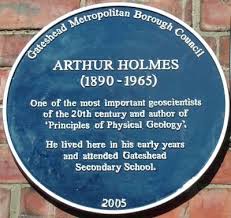By: Jeremy Rowzee
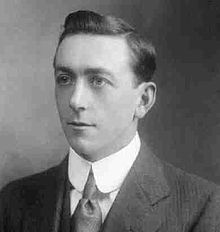
I selected renown Geologist Arthur Holmes, because of his geological contributions to the scientific community. Holmes continued the works of Wagener elaborating the continental drift theory, which is now known as plate tectonics. Holmes also revolutionized the way we carbon date within the Geology Field through radioactive dating. In addition, Holmes was a renowned scholar at several Universities in England. Still today scientist base their geological theories and methods from Arthur Holmes life works and achievements. Holmes theoretical thinking was beyond his time and while his peers occasionally opposed his theories, Holmes work was subsequently proven to be on point.
Biographical Information:
British Geologist Arthur Holmes was born in 1890, in the small town of Gateshead United Kingdom where he spent his childhood. At the age of 17, Arthur Holmes attend Gateshead Grammar School before enrolling into the Royal College of Science or The Imperial College London, where he studied Physics. In Arthur’s second year of school he was introduced to geology, which later became his passion. After graduating from college Holmes found work in Africa as a mineral prospector, which he had little success. Within six months of arriving in Africa Holmes became extremely ill with malaria from mosquitos. Meanwhile, Holmes family and friends where told that Holmes had died in Africa, which they mourned his thought to be death. Within a few months Holmes gathered enough strength to voyage back to London where he surprised his family and friends. Soon after his return Holmes was offered a position at the Imperial College London as an activist in 1912. Holmes earned Doctoral Degree of Science in 1917.

Scholar Works:
British Institutions: Durham University (1924–1942), and University of Edinburgh (1943–1956). In 1924 Holmes became the reader in geology at Durham University. After nine years at Durham University, Holmes was promoted to the chair of geology at the University of Edinburgh, which he held until his retirement in 1956.
Specific contributions to the theory of plate tectonics and/or our modern view of the solid Earth
Scientific Theories:
English geologist Arthur Holmes made not one but two major contributions to our under-standing of how the Earth works. He was the first earth scientist to grasp the mechanical and thermal implications of mantle convection, and he widely applied the newly-developed method of radioactive dating to minerals in the first attempt to quantitatively estimate the age of the Earth.
Continental Drift: Convection of Earth's Mantle
Holmes advocated the theory of continental drift fostered by Alfred Wegener at a time when it was profoundly unfashionable with conformist. One problematic concern with the theory was the mechanism of movement, which Holmes advised that Earth's mantle contained convection cells that dissipated radioactive heat and moved the crust at the surface. Holmes in his Principles of Physical Geology concluded with a chapter on continental drift. Portion of the model was the concept of the origin of the seafloor spreading. Like Wagener, one of the most remarkable attribute about Holmes is he proposed his hypothesis at a time when continental drift was not accepted within the scientific community. Holmes knew his hypothesis to continental drift theory needed to necessitate more evidence in order to either disprove or prove. Holmes was solely looking for the primary mechanism to explain how identical geological and biological evidence could occur on two different continents across an ocean. Holmes’s hypothesis not only produced a mechanism by which the continents could move, it also provided a probable explanation for continental rifting and mountain formation. Holmes primary contribution was his proposed theory that convection occurred within the Earth's mantle, which explained the push and pull of continent plates together and apart. He also assisted scientists in oceanographic research in the 1950s, which publicized the phenomenon known as sea floor spreading. Soon after in the 1960's the theory of plate tectonics was established.
Geological Time Scale:
Before Arthur Holmes earned his Doctoral Degree in 1913, Holmes had already formed the first geological time scale. Holmes used a relatively new discovery of radioactivity to assist him in the creation of the Earth’s geological time scale. By using his newly quantitative time scale and other scientific factors, he made an estimate of Earth's age that was far older than his colleagues had suggested until the present calculation of 4 billion years. His initial estimates of Earth's eras have held up remarkably well over time: For example, he placed the beginning of the Cambrian period at around 600 million years ago; today 590 million years is the time frame largely accepted. Holmes was known as the "Father of Geological Time Scale".
Example of Geological Time Scale
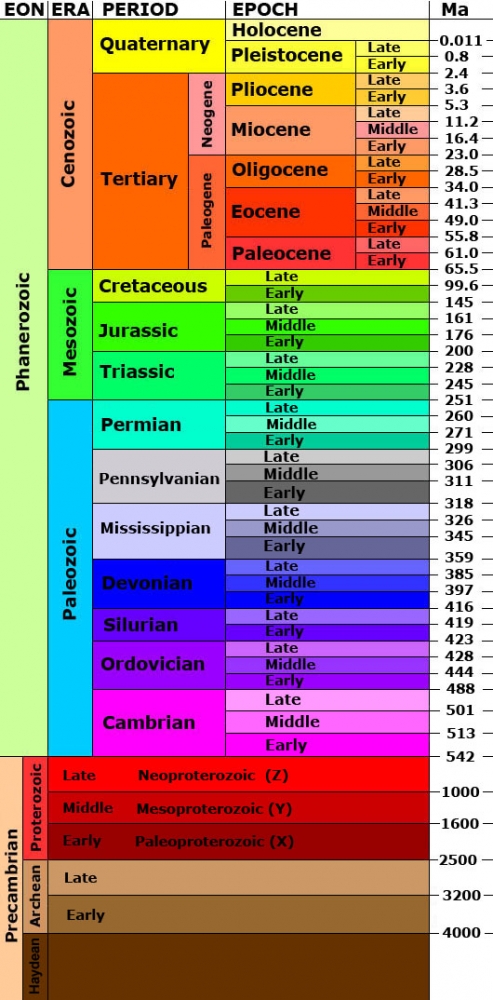
Radioactive Dating:
In the early 20th century, a young Holmes had instituted the use of radioactivity in calculating the age of the Earth. Because radioactive decay happens at a steady rate, it enables us to date rocks by measuring the amount of the original unstable element and the resulting "daughter" element. Early attempts to date rocks in this way measured the amount of helium given off in the decay process, but when scientists realized that they couldn't capture all the helium, the young Holmes pointed to an alternative solution. Holmes achieved creditability upon him demonstrating his dating capabilities early on by estimating rock samples from various geologic periods. He gave a Carboniferous sample an age of 340 million years, a Devonian sample an age of 370 million years, and a Silurian sample an age of 430 million years. All three estimates fall with the time spans given by present-day geologists for those periods. Holmes spent the rest of his career refining his estimate numbers. His final number was ultimately overturned by other scientists in the 1950s, who estimated an age of over 4.5 billion years, but he laid the groundwork for radiometric dating.
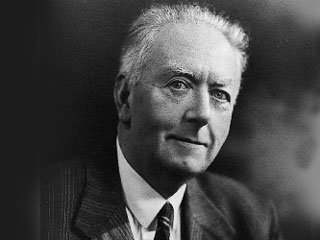
Other important scientific contributions
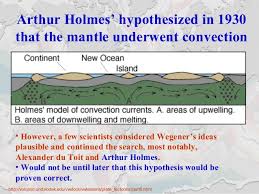

Scientific Works:
- The age of the earth 1913, Harper & Brothers, 2nd edition 1927, 3rd edition 1937.
- The nomenclature of petrology, with references to selected literature. Thos Murby, London, van Nostrand, New York, 1920, 2nd edition 1928.
- Petrographic methods and calculations with some examples of results achieved Thos Murby, London, 1921, 2nd edition 1930.
- Radioactivity and Earth Movements, Trans Geological Soc, Glasgow, vol 18, pp 559–606. pdf
- Principles of Physical Geology 1944, Thomas Nelson & Sons, 2nd edition 1965, 3rd edition (with Doris Holmes) 1978, 4th edition (with Donald Duff) 1993.
- The Phanerozoic time-scale; a symposium dedicated to Professor Arthur Holmes Geological Society, London, 1964.
Publications:
In 1944 he published the first edition of his Principles of Physical Geology, which became a standard text-book in the UK and elsewhere.
Other cool stuff you should know:
Awards:
- He was awarded both the Wollaston Medal and the Penrose Medal in 1956.
- The Arthur Holmes Medal of the European Geosciences Union is named after him.
- The Durham University Department of Earth Sciences' Arthur Holmes Isotope Geology Laboratory is named after him, as is the students' Geology Society.



- A crater on Mars has been named in Arthur Holmes honor.

Bibliography
"Arthur Holmes: Harnessing the Mechanics of Mantle Convection to the Theory of Continental Drift." American Museum of Natural History. Web. September 4, 2015. http://www.amnh.org/education/resources/rfl/web/essaybooks/earth/p_holmes.html
"Arthur Holmes." Wikipedia, the Free Encyclopedia. Web. September 4, 2015.http://en.wikipedia.org/wiki/Arthur_Holmes
"Complete and Updated Biography for Arthur Holmes." A Collection of the Most Interesting Biographies - Updated and Complete. Web. September 6, 2015.http://www.browsebiography.com/bio-arthur_holmes.html
"EGU Awards & Medals | Arthur Holmes." EGU Home. Web. September 4, 2015. https://www.egu.eu/awards-medals/portrait-arthur-holmes/
Frankel, Henry. (1978). "Arthur Holmes and Continental Drift." The British Journal for the History of Science 11(2) p.130-50. JSTOR. Web. September 7, 2015 http://www.jstor.org/stable/4025726
"Holmes, Arthur (1890-1965): World of Earth Science." ENotes - Literature Study Guides, Lesson Plans, and More. Web. September 5, 2015.http://www.enotes.com/earth-science/holmes-arthur
"Plate Tectonics." Wikipedia, the Free Encyclopedia. Web. September 8, 2015.http://en.wikipedia.org/wiki/Plate_tectonics
"Rocky Road: Arthur Holmes." Strange Science: The Rocky Road to Modern Paleontology and Biology. Web. September 4, 2015. http://www.strangescience.net/holmes.htm
